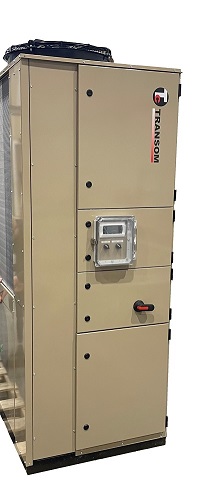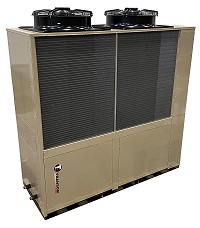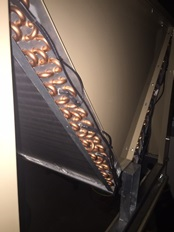Currently, there is a demand for decarbonization projects to eliminate gas and oil heating as a source. The Hatch Hot Water Air Source Heat Pump is specifically designed for these kind of decarbonization projects.
Contents
- Replacement Boiler Projects
- New Build
- Domestic Hot Water Projects
- Heating / Cooling Projects
- Heating / Cooling / Domestic Hot Water Project
- Capacity Control
- Defrost
- Source Temperatures
- Supply Temperatures
- Potable Water
- Alternate Source Points
- The Capacity Range
- Elec Trim and Back-up Heat
- Built-in Pump
- Heat Tracing
- Drain Pan
- Foot Print
Replacement Boiler Projects

Traditional gas and oil boilers, for high rises, hospitals and other institutions, are typically based on higher system supply water temperatures. The system loop, radiators and fan/coils are designed for the higher temperatures.
The Hatch Air Source Heat Pump offers a number of configurations that are designed to achieve leaving water temperatures of either up to 150°F. This way the heat pump is a direct replacement of the boiler.
Traditional heat pumps can only achieve 140°F supply temperatures. Therefore, the entire piping system, radiators and fan coils would also have to be replaced. To compensate for the lower water supply temperatures, the flow rates and radiators have to be increased so total heat capacity is met, thereby, increasing in the total capital expenditures and extending the return on investment (ROI).
By using the Hatch Air Source Heat Pump, it becomes a boiler replacement project instead of a heating system replacement project. This greatly reduces the amount of capital expenditures, and bring the ROI into the proper range to make the project viable.
HWV model 140°F from -20F ambient
HWR model 180°F from 10F ambient
For the 180°F leaving water, air source heat pump go to the Hatch Recip Model
New Build
With new build projects a lower leaving water temperature can be utilized which allows more options for the configuration of the Hatch Air Source Heat Pump. Fan, coils and radiators are designed for temperatures in the 140-150°F range it allows for more options in the compressor and heat pump configuration.

If floor loop heating is utilized then lower temperatures can be further lowered to 100-110°F. The lower leaving temperature will not require the heat pump to do as much work and, in turn, increase the coefficient of performance (COP) and reduce the ROI.
Domestic Hot Water Projects
The Hatch Air Source Heat Pump configuration for domestic hot water heating utilizes a double walled heat exchanger. It also uses a control strategy to vary the set point to boosts the water temperature to prevent Legionella. With single pass and stratified tanks the efficiency can be increased by 23%.
Heating / Cooling Project
The Hatch Air Source Heat Pump can also be built as a reversing heat pump. Providing both heating and cooling water so that it is utilized through the year.

Heating / Cooling / Domestic Hot Water Project
The reversing Hatch Air Source Heat Pump can also be configured to have a dual glycol loop. At low ambient temperatures both the primary and secondary loop provide heating for the system. Alternately, at high ambient temperatures the primary and secondary loop provide chilled water.
During the remainder of the year, the secondary loop which has its own circulation pump is directed to the domestic hot water loop to provide pre-heating. Depending on the location of the project this can be over 85% of the year.
Capacity Control
With the Hatch Air Source Heat Pump unit, the capacity generated varies with the ambient temperatures. This will result in the capacity generated higher ambient temperatures being greatly increased. If this is not addressed then it will lead to excessive cycling of the compressor which in turn, will lead to greater fluctuation in the system supply temperature. With the Hatch Air Source Heat Pump it is designed with variable capacity compressors. This way high discharge temperatures can be generated while keeping the compressor running with in proper cooperating conditions.
The Hatch Air Source Heat Pump control strategy utilizes a dead band system which will maintain the supply temperature within 2°F. It will unload the stages as the load requires it.
With larger loads multiple units can be used which will give large turn-down capabilities. As well, an extra module can be added to allow for back-up (N+1).


Defrost

The Hatch Air Source Heat Pump utilizes defrost rides imbedded in the air coil. This will eliminate the need for reversing the system in the middle of winter, which would generate chilled water, undoing some of the heating load already generated. This way, the system capacity and COP remains high.
Source temperatures
Different geographical areas allow for different designs and operating conditions. The Hatch Air Source Heat Pump has been designed to operate as low as -20°F (-29°C). Depending on the requirements different strategies can be utilized to maximize the capacity and COP for these conditions.
Supply temperatures
A number of different design temperatures can be achieved with the Hatch Air Source Heat Pump. It can generate 140°F while operating at -20°F.
Potable water
The hot sheet air source heat pump can be built with double walled heat exchangers to be utilized for potable water.
As well, the controller is set up so that it will raise the temperature every time as designated by the user and to raise the setpoint up to 150°F to counteract the possibility of Legionnaires disease.
Alternate source points
If ultimate source points are available like ground source or process loops, then the Hatch heat pump can be built as a water to water configuration. This way it will take advantage of higher source temperatures.
As well, if there is dual chilled water and hot water requirements such as sports arenas or process applications then the Hatch Water Source Heat Pump control strategy will be set up to control on both points.
The Capacity Range
The Hatch Air Source Heat Pumps are available from 48 MBH to 560 MBH at 45°F ambient temperature. With the modular unit configuration, controlled by the central controller, the capacity can be increased to 6700 MBH (12 modules).
Elec Trim and Back-up Heat
The Hatch Air Source Heat Pump has an option back up heat. It is integral with the heat pump so that no external or secondary elec power connection is needed. The heater is 0-100% variable capacity so that it will trim up the BTUs generated at low ambient temperature to produce a flat capacity line over the ambient range. It works in conjunction with the BIN hours resulting in a very low change in overall COP.

Secondly it can be used to recharged the storage tanks during the night to make the full storage tank available at full temperature to counteract tank temperature loss.
Built-in pump
The Hatch Air Source Heat Pump has a built-in circulating pump. It is controlled in conjunction with load demand and the compressor. This way it does not dilute the stratified tank temperatures. The built in pump also means less installation cost. The pump is available at standard and high external pressure.
Heat Tracing
For potable water application the Hatch Air Source Heat Pump has a heat tracing option. It is applied to all wetted parts internal to the machine and is further insulated. The heat tracing has a separate connection box. This allows users to connect their back up power system. Ensuring the heat tracing is functional at a power outage.

Drain Pan
Inside of the air coil the Hatch Air Source Heat Pump is equipped with a stainless-steel drain pan. It has a removable grill and a access port. It is also equipped with heat tracing to ensure it is fully functional during the colder periods of the year.
Foot Print
The Hatch Air Source Heat Pump lends itself to projects located in mid-density and high-density locations such as institutional buildings or high-rise buildings. The Hatch Air Source Heat Pump can be located on roofs, side yards, etc. It does not require large foot prints as utilized by other types such as ground source heat pumps.
